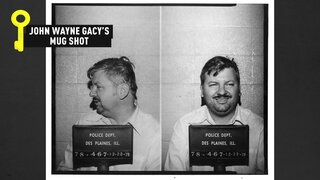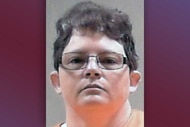Create a free profile to get unlimited access to exclusive videos, breaking news, sweepstakes, and more!
How John Wayne Gacy Survivor Jeffrey Rignall Went On A Personal Mission To Stop Him From Hurting Others
Jeffrey Rignall was lured into John Wayne Gacy's car, chloroformed and then brutally raped and beaten. When police downplayed the attack, he decided to conduct his own search for his attacker.

As John Wayne Gacy’s basement crawl space was running out of room for the bodies of his victims, a man named Jeffrey Rignall survived a horrific encounter with the serial killer. Now, Peacock’s new docuseries, “John Wayne Gacy: Devil in Disguise,” shows how, in the face of trauma and the deeply entrenched societal homophobia of the 1970’s, Rignall made it his mission to find Gacy and keep him from hurting anybody else.
Rignall was 26 in March of 1978 when John Wayne Gacy pulled up beside him in his Oldsmobile, inviting him in to smoke some marijuana, the Associated Press reported in 1980. As Rignall would later testify at Gacy’s murder trial, he took a few puffs before Gacy “hit [him] in the face [with] a dish cloth or rag” soaked in chloroform. On the stand, Rignall described a cold feeling and buzzing sound in his head before he lost consciousness.
In “John Wayne Gacy: Devil in Disguise”, Rignall’s partner of 22 years, Ron Wilder, details how Rignall dipped in and out of consciousness on the drive to Gacy’s suburban home. Once inside, Gacy tortured the young man, tying him up and repeatedly beating, raping, and chloroforming him.
After the attack, Gacy dumped Rignall off in a spot not far from where he’d first picked him up. Wilder describes the horrifying injuries Rignall suffered from the attack. He was bleeding, sick, and covered in rope burns. Photos taken at the time show chloroform burns all over his face. Despite all the physical evidence that he had been badly assaulted, the police didn’t seem to take Rignall’s account very seriously when they interviewed him in the hospital. William Kunkle, retired Judge of the Circuit Court of Cook County describes his story at the time as “vague,” saying Rignall didn’t know where the house was or what it looked like, “so it was a very minimalist police report and nothing transpired.”
Wilder, however, claims that the police simply chose to ignore what happened because Rignall was gay.
“The police assumed that Jeff’s encounter with Gacy was a consensual arrangement,” he says. “They had no clue of how to treat a gay rape of any sort and did not even think that would be possible.”
Alexa Danner, executive producer of the docuseries echoed that sentiment, telling Oxygen.com that, “Rignall felt very much that he was dismissed by the police because of the attitudes at the time towards homosexuality. It’s really hard to look back on that time today and understand how that could happen, but it was a different time, but it caused a lot of suffering for that particular victim,” she explained.
While police didn’t seem to think the situation was that serious, Rignall felt in his gut that it was.
“Jeff thought that man could kill somebody so he figured whatever he did to him, he was going to do it to other people,” Wilder says in the docuseries. “That’s why he wanted to catch him.”
So, Rignall began doing his own investigation. While he didn’t know Gacy’s name or who he was, he knew what his car looked like and had a rough memory of the license plate. He also remembered hearing airplanes during the attack, so he knew that the house was in close proximity to the airport.
“Since the police took the matter very, very lightly and I felt that, you know, it wasn’t a light matter, I rented a car and sat where I thought I was approximately, waiting for his car to come by,” Rignall said in a CBS 2 Chicago broadcast, excerpted in the docuseries.
Wilder accompanied Rignall during his stake-outs. He said they went out every day they could.
Within less than a month, they spotted Gacy’s car, and trailed him. Rignall jotted down the license plate number, which he provided to police.
“He ended up [...] working to find out Gacy’s identity himself and then pushing the case as far as he could through the court system,” Danner told Oxygen.com.
Gacy was arrested, but quickly released on a minor bond. The two men tried to get the charges bumped up but Wilder claims that the state’s attorney dismissed them, using homophobic profanity.
In December of 1978, following the disappearance of 15-year-old Robert Piest, Gacy was questioned and arrested by police, who obtained a search warrant for the crawl space beneath Gacy’s home. Almost immediately, they discovered human remains. Nine months after Rignall was attacked, Gacy was arrested. This time he was charged with murdering 33 men and boys.
Rignall and Wilder published “29 Below” a book about the attack and the couple’s subsequent investigation into Gacy’s identity in 1979. Now out of print, used copies can go for hundreds of dollars online. Following the book’s publication, Gacy’s defense team called Rignall as a witness, believing his story would help their insanity defense. Rignall testified about his rape and torture, at one point becoming overwhelmed and sick while recounting the details. Gacy was found sane and convicted. He was put to death in 1994.
Danner told Oxygen.com that Rignall’s life” was very difficult for him after the incident, after the assault.”
However, she noted that Wilder was his “rock” who "just showered him with love throughout.”
Rignall died in 2000 at the age of 49.
Watch "John Wayne Gacy: Devil in Disguise" now on Peacock. You can also catch the first episode of the six-part series on Oxygen on Sunday, April 18 at 12:30 a.m. ET.
Oxygen correspondent Stephanie Gomulka contributed to this report.

























